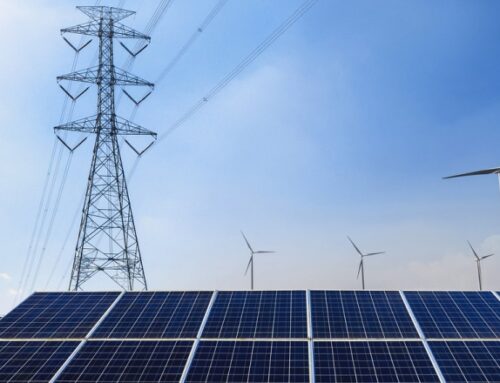Welcome renewable energy to our wild lands
October 1, 2025
When I see a wind turbine on the horizon, I see something beautiful.

Bill McKibben is a distinguished scholar at Middlebury College and the founder of Third Act, which organizes older Americans on climate and democracy. He recently led a nationwide climate day of action, Sun Day, and his new book is “Here Comes the Sun: A Last Chance for Climate and a Fresh Chance for Civilization.”
In August, Interior Secretary Doug Burgum announced that federal lands would be essentially off limits to wind and solar power projects — they took up too much land, he said.
It would be easy enough to just dismiss this as one more favor for the fossil fuel industry (which it clearly was) — after all, it’s still fine to use the millions of acres of federal land for coal mining and oil and gas drilling, each of which does permanent injury. And we graze cows on millions of acres of land, doing deep damage to grasses and soils, even though all that grazing produces less than 2 percent of the country’s beef. Oh, and the same Republican Party tried to sell off millions of acres of federal land to developers in the spring, until an avalanche of public opinion convinced Congress to take a pass.
Still, it’s worth really thinking through Burgum’s point. Because in my experience many much more well-intentioned people — people who truly want a world that runs on clean energy — nonetheless believe that uninhabited lands shouldn’t be used for big solar arrays or multistory wind turbines that can be seen for miles.
I’m in agreement that we should first use rooftops and build canopies over parking lots to host solar panels — one glance at my own shingles proves that point. But there’s not enough acreage up there to produce the electricity we need, especially as we convert our car fleet to EVs and replace our furnaces with electric heat pumps. We’re going to need some other land as well. Not all of it by any means — Stanford University’s Mark Jacobson, who has put together the most extensive catalog of requirements for every state, says we will need less than 2 percent of the country’s surface area, which may end up being less than is currently used for fossil fuel development, and certainly no more. But definitely some. We’re going to have to realize that clean electrons are an essential crop, like food and like timber.
It’s easiest to see how this tradeoff works in farm country. We currently devote 30 million acres, or half the country’s corn crop, to producing ethanol. Which is to say, we’re already growing lots of energy, just inefficiently. You have to pour nitrogen and phosphorus onto these solar collectors we call corn stalks, and douse them with herbicides and pesticides — and you still get a tiny fraction of the energy per acre that you would if you just covered that land with solar panels.
When I say “cover,” I don’t necessarily mean nothing but glass panels to the horizon. Around the world we’re figuring out how to use land for multiple purposes at the same time. Lots of plants love the shade and moisture that solar panels provide and preserve. Grape yields are up 50 percent in some places, for instance; you don’t have to search very hard to find pictures of happy goats and cows resting in the shadows cast by solar panels. Even desert botanists are finding that the shade of solar arrays helps the regeneration of the biological crust so essential for life in such a harsh environment. In Vermont, where I live, many solar farms have the rows between panels planted with pollinator-friendly plants.
In places like New England, though, renewable energy can’t just come from our limited farmland. At this latitude, the best resource is often the wind — for that we have to look to our oceans and mountains. Offshore, in places like Block Island, they’re now finding that the footings for big turbines make dandy artificial reefs, helping fish find room to spawn. Onshore, there’s no question that they damage mountain ridges, and you wouldn’t want them everywhere, but I’ve long hoped they’ll come to the pass above my home.
And that’s because I know where the real threat to those mountains lies. It’s not from a few scattered outposts of wind power; it’s from the rapid warming of our planet, which threatens every part of the outdoors that we hold dear. For instance: I love winter in these mountains the very best, because it’s the season when friction gives up its grip on the world, when we can glide across its surface with giddy grace. But winter gets shorter with each passing year; it feels as if we’re going to be a region where January and February just mean a sun-deprived mud season. And if that’s tough on me, it’s tougher on every other creature that hangs out here. The moose that wander our woods now carry ticks numbering in the tens of thousands, because it’s so warm the bugs won’t die. Those same ticks mean that millions of parents now hesitate to send their kids outdoors to play, threatening to alter forever our relationship with the outdoors, and that makes me sadder than I can say. I want my grandson to be outdoors every day, and I want him to know that every swamp just might hold a moose.
Renewable energy is booming everywhere around the world except here. In China this past spring they were putting up three gigawatts worth of solar panels a day — a gigawatt is the rough equivalent of a coal-fired power plant. But Americans have put more carbon into the atmosphere than anyone else, and so we have a deeper practical and moral debt to pay off. We have a land of extraordinary beauty to protect.
A crucial way to do that is by figuring out a new aesthetic. When I see a wind turbine on the horizon now, it looks beautiful to me — both because it’s a kind of giant kinetic sculpture, the breeze made visible, and because it looks like human beings taking responsibility for their planet. When I look at a solar farm, I think about how amazing it is that the sun, which already provides us with warmth and light and photosynthesis, is now willing to give us all the power we could ever need.
Search
RECENT PRESS RELEASES
Related Post




